Abstract
Steel cargo vessel sinking accidents (SCVSA) threaten maritime safety and disrupt global steel supply chains. This study integrates interpretive structural modeling (ISM) and fuzzy Bayesian networks (FBN) to evaluate SCVSA risks across the incident lifecycle. ISM identifies hierarchical relationships among multifaceted risk factors. FBN assesses lifecycle risks using fuzzy scoring, modular nodes, and a hierarchical structure, with muti-source data drawn from accident reports, expert opinions, and research studies. Experts estimate probabilities based on observations and causal scenarios involving steel cargo vessels at Shanghai Port. The ISM–FBN framework visualizes hierarchical risk factors and incorporates uncertainty in the data and causal relationships through fuzzy scoring, structural updates, and probability learning. This approach provides a robust and adaptable tool for assessing SCVSA risks, advancing maritime risk assessment methodologies. Key findings identify advanced vessel age, severe weather and sea conditions, and inadequate regulatory oversight as primary root causes. Poor cargo loading and stowage practices are direct contributors. Intermediate risk factors from deeper to surface layers flow from shipping companies to crew and further to vessel and environmental conditions. Multi-stage risk factors include inadequate emergency responses and improper cargo securing. To mitigate these risks, actionable insights are provided, including fleet modernization, enhanced regulatory compliance, crew training, and improved emergency preparedness.
1. Introduction
The maritime industry is a cornerstone of international trade, facilitating the global movement of essential goods. Among these commodities, steel is vital for infrastructure construction and serves as a critical component of the global supply chain. However, the maritime transport of steel presents unique challenges due to its high density, low stowage factor, variable shapes, and weight differences. The high density increases the stress on the vessel’s structure, requiring careful stowage to maintain stability. The low stowage factor results in concentrated weight in limited spaces, raising cargo shifting risk. Additionally, the varying forms of steel—such as coils, plates, and bars—complicate load securing and stability, necessitating specialized handling techniques.
Steel cargo vessels (SCVs), essential for transporting steel, are prone to sinking incidents, causing severe losses in life, property, and economic value. Recent cases illustrate this concern. In 2021, a vessel carrying 5529 tons of steel sank near Maoming, resulting in two fatalities, one missing person, and an economic loss of 32.9 million yuan. In 2020, another steel-laden vessel sank near Dajin Island, causing two deaths and a loss of 4 million yuan. As demand for steel transport increases, it is urgent to identify and mitigate the risks associated with steel cargo vessel sinking accidents (SCVSA).
Despite the importance of SCVs, existing studies primarily focus on general cargo ships and bulk carriers, neglecting the distinct and complex risks associated with SCVs. SCVs face structural challenges and operational hazards that differ significantly from those encountered by other types of ships. Traditional maritime risk assessment methods, such as fuzzy logic, fault tree analysis, and Bayesian networks, often fail to capture the intricate multi-stage causal relationships in sinking incidents. These approaches overlook the dynamic and interconnected nature of risks, especially when considering factors like aging vessel conditions, insufficient crew training, and regulatory gaps. A more tailored risk assessment framework for SCVSA is needed, integrating advanced methods to address these complexities.
SCVs, particularly smaller vessels operated by resource-constrained companies, face compounded risks due to aging fleets, insufficient crew training, and limited regulatory oversight1. These vessels are often part of aging fleets, which are more prone to structural failures, increasing the risk of incidents. Additionally, crew members may lack the necessary training to handle critical tasks such as securing cargo and responding to emergencies, further exacerbating the risk. Regulatory gaps, including inadequate inspections and the absence of guidelines for properly securing steel cargo, contribute to the vulnerability of these vessels. This combination of factors leads to a heightened risk of accidents, including vessel sinkings, which are not adequately addressed by current risk management practices. This research explores how these unique vulnerabilities can be systematically assessed and mitigated, offering new insights into improving SCV safety and operational standards.
To tackle these challenges, this study introduces an integrated framework that combines interpretive structural modeling (ISM) and fuzzy Bayesian networks (FBN) to evaluate SCVSA risks across all stages of an incident’s lifecycle. The ISM framework identifies the hierarchical relationships among risk factors. The FBN approach incorporates probabilistic modeling to assess the cascading effects and interactions of these risks. Fuzzy theory is employed to address uncertainty and ambiguity in expert opinions, enhancing the reliability of risk assessment data [,,]. This integrated approach seeks to answer the following four key questions: (1) How do risk factors interact and compound across the SCVSA incident lifecycle? (2) How do risks evolve over the course of these incidents? (3) What are the primary drivers of SCV risks? (4) How to improve the risk prevention and control capability for SCVSA?
This study advances maritime risk management methods by constructing an ISM–FBN model for evaluating SCVSA risks through the incident lifecycle. The model provides a comprehensive understanding of multi-stage risk hierarchies. The findings offer practical insights for improving SCV safety by addressing multi-stage risks and developing effective prevention and emergency response strategies.
2. Literature Review
SCVs face diverse risk factors that threaten their operational safety. Steel is primarily transported by general cargo vessels or bulk carriers. General cargo vessels typically transport bundled steel, plates, and pipes, while bulk carriers carry steel billets and coils. Table 1 summarizes key studies on maritime risk assessment for bulk carriers and general cargo ships.

Table 1.
Maritime risk assessment studies for bulk carriers and general cargo ships.
2.1. Steel Cargo Vessel Sinking Risk Factors
Despite SCVs’ importance in maritime trade, studies specifically addressing the risks associated with SCVs remain limited. Existing research has largely focused on risks such as fire incidents [], collisions [], human-made hazards [], and sinking accidents [,] involving general cargo ships and bulk carriers. Among these, only Kaptan [] analyzes steel-transporting bulk carriers but focuses exclusively on human-made hazards. To date, no research has systematically analyzed the sinking risks of SCVs. This study addresses this gap by providing a comprehensive analysis of the causal hierarchies and lifecycle risks associated with SCVSA.
Previous studies identify ship conditions, crew performance, and environmental factors as primary contributors to maritime accidents [,]. However, there has been limited attention to risk factors related to cargo, shipping companies, and maritime regulatory agencies. Cargo-related risk factors primarily focus on cargo type [] and loading operations []. Shipping company-related risk factors are often associated with safety culture and management systems [,]. Regulatory risk factors largely center on regulation and supervision [,]. Despite this, the risk factors specific to SCVSA remain underexplored. This paper expands upon prior research by including additional dimensions, such as cargo loading practices, the role of shipping companies, and the impact of maritime regulatory authorities, providing a more holistic view of SCVSA risks.
2.2. Maritime Risk Assessment Methods
Traditional methods for maritime risk assessment, such as fuzzy logic [], fault tree analysis (FTA) [,], and BNs [], have been widely applied but face notable limitations in addressing the lifecycle risks of SCVSA. Fuzzy logic (FL) is effective for handling uncertainty and imprecision in risk assessment. However, it lacks the capability to represent and analyze complex multi-level causal relationships inherent in SCVSA. This makes it insufficient for capturing the interdependencies of risk factors. FTA identifies risk factors and root causes but assumes linear and static risk propagation. This assumption limits its ability to evaluate multi-stage interconnected risk events. FTA is less effective in addressing the dynamic and hierarchical nature of risk factors in SCVSA, such as the interplay between cargo stowage practices, crew performance, and environmental factors throughout the lifecycle. BNs are powerful in modeling probabilistic dependencies and causal relationships, making them suitable for analyzing uncertain and complex risk scenarios. However, their reliance on extensive, high-quality historical data presents a challenge for SCVSA, where such data are often incomplete or unavailable.
In recent years, machine learning, deep learning, and virtual reality technologies have been applied to maritime safety perception and equipment failure predictions [,,]. AI-based methods analyze vast amounts of historical data to predict the likelihood of seafarers’ diseases or accidents [,]. While promising, their application to risk assessment of SCVSA remains limited. This limitation is due to insufficient historical data for training AI models and concerns about the reliability of AI technologies, especially for high-risk events like sinking incidents.
2.3. ISM–FBN Framework
This study proposes an integrated framework combining ISM and FBN to overcome these limitations. ISM systematically differentiates and visualizes multi-level causal hierarchies, offering an intuitive representation of risk propagation [,]. The advantages of ISM in analyzing SCVSA risks are as follows:
- (1)
- Hierarchical causal representation: ISM effectively visualizes multi-level causal relationships, helping to understand how risks propagate across different stages of an incident’s lifecycle. Unlike FTA, which assumes a top-down, static structure, ISM dynamically captures interdependencies and feedback loops.
- (2)
- Flexibility and expert integration: ISM can integrate expert opinions to build causal hierarchical frameworks, which is particularly valuable in SCVSA, where historical data are limited.
- (3)
- Multi-stage risk factor analysis: ISM can analyze complex causal relationships across multiple stages of an incident. FTA typically evaluates risks in a static and linear fashion. Unlike FTA, ISM identifies interconnected risk factors across different phases, such as how improper cargo stowage propagates through navigation risks and contributes to sinking incidents.
While ISM excels in causal modeling, it does not quantify probabilities or address uncertainty. To overcome this, the ISM–FBN framework integrates ISM with fuzzy theory and Bayesian networks. Fuzzy theory enhances the framework’s ability to process uncertain expert opinions [] and is flexible enough to be combined with other methods [,,]. FBN complements ISM by integrating fuzzy theory to address uncertainties in probability estimation and multi-stage risk events []. Together, these methods incorporate accident reports and expert opinions to validate the likelihood and causal relationships of risk factors, providing a robust and comprehensive methodology for assessing the lifecycle risks of SCVSA.
2.4. Summary
- (1)
- Limited focus on SCV-specific risks: While previous studies have addressed general risks such as fire incidents, collisions, and general sinking accidents, systematic investigations into the specific risks associated with steel cargo vessels are absent. Particularly, the unique risk factors related to cargo stowage, shipping companies, and regulatory authorities remain underexplored. ISM is well-suited for constructing a detailed causal framework that captures the interplay of these multifaceted factors.
- (2)
- Challenges in lifecycle risk assessment: SCVSA involves risks across multiple stages of an incident’s lifecycle. Existing methods fail to model these lifecycle risks holistically. The ISM–FBN framework bridges this gap by systematically identifying and evaluating multi-stage risks, enabling a more comprehensive understanding of the issue.
- (3)
- Deficiencies of traditional risk assessment methods: Traditional maritime risk assessment methods, such as fuzzy logic, fault tree analysis, and Bayesian networks, face limitations:
- Fuzzy logic: effective for managing uncertainty, but inadequate for representing complex causal hierarchies in SCVSA.
- Fault tree analysis: useful for identifying root causes but insufficient for addressing multi-stage, interconnected risk events.
- Bayesian networks: capable of modeling probabilistic dependencies but reliant on extensive high-quality historical data, which is often unavailable for SCVSA.
The ISM–FBN framework overcomes these limitations by providing a systematic structure for causal relationships and incorporating fuzzy theory to handle data scarcity and uncertainty.
- (4)
- Trust and adoption of AI-based risk assessments: AI-based methods, while promising, face skepticism from regulatory authorities due to the perceived opacity of AI models and the severe consequences of SCVSA. The ISM–FBN framework combines the transparency of ISM with the probabilistic reasoning of BNs, offering a more trustworthy approach to maritime risk assessment.
- (5)
- Validation through expert input and accident reports: Unlike traditional methods that rely on large-scale historical datasets, the ISM–FBN framework leverages expert opinions and accident reports to validate causal relationships and probability estimations. This adaptability makes the framework particularly suited to data-scarce contexts like SCVSA.
By addressing these research gaps, the ISM–FBN framework not only advances the understanding of SCVSA risks but also provides a practical tool for enhancing safety and decision-making in maritime operations.
3. Materials and Methods
This study adopts a systematic multi-stage approach to identify the causal hierarchy and evaluate the lifecycle risks of SCVSA (Figure 1). The process is outlined as follows:
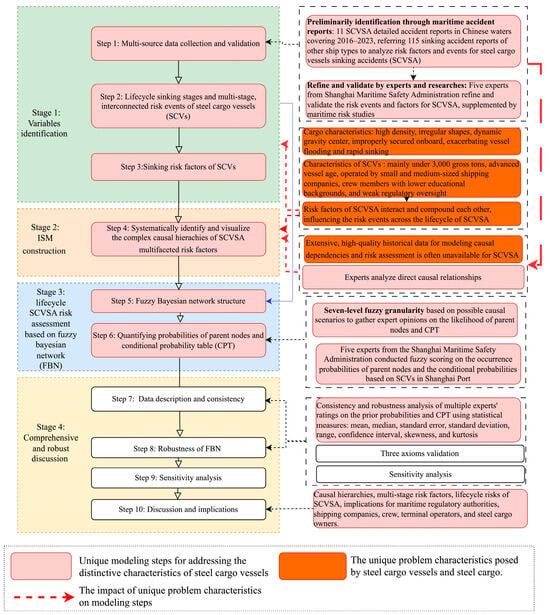
Figure 1.
Methodology flowchart.
(1) Multi-source data collection and validation
Risk factors and events were identified from maritime accident reports and further refined through expert consultations and relevant studies. Experts were selected using a structured evaluation process based on the criteria outlined in Section 3.1. This ensured both their suitability and the reliability of their input.
(2) ISM
The ISM framework was applied to uncover the causal hierarchy among the identified risk factors. This process systematically structures the relationships between factors, providing a clear visualization of risk transmission pathways and dependencies.
(3) FBN
The outputs from ISM were integrated into an FBN to model and quantify risk probabilities. The FBN incorporates expert-derived fuzzy scores to handle uncertainty and incomplete data, enabling probabilistic evaluation of complex multi-stage risks. The combined use of ISM and FBN leverages their respective strengths: ISM’s ability to define and visualize hierarchical causal relationships and FBN’s capacity for probabilistic reasoning under uncertainty. This dual-method framework provides a comprehensive tool for analyzing the complex interdependencies and uncertainties inherent in SCVSA. It overcomes the limitations of traditional risk assessment methods that fail to integrate causality and probabilistic modeling effectively.
(4) Consistency and robustness evaluation
The consistency and robustness of the expert-derived fuzzy scores and FBN outcomes were evaluated using statistical measures, three established axioms of the Bayesian network, and sensitivity analysis. These steps ensure that the framework reliably captures expert opinions and responds appropriately to variations in input parameters.
The research methodology was designed to address the unique characteristics of SCVSA, as illustrated in Figure 1. These characteristics influenced several aspects of the method, including data collection and validation, lifecycle risk events categorization, classification and causal relationships of risk factors, fuzzy granularity levels, and the discussion and implications.
3.1. Multi-Source Data Collection and Validation
This study adopts a two-step approach to collect and validate data for analyzing the lifecycle risks, causal relationships, and critical factors associated with SCVSA. The approach is designed to address data limitations and incorporate mechanisms for handling data uncertainties inherent in SCVSA risk analysis.
(1) Data collection:
A total of 126 maritime sinking incident reports from 2016 to 2023 were gathered from the Shanghai Maritime Safety Administration and China Maritime Safety Administration (Figure 2). These reports cover various vessel types (Figure 3), cargo types (Figure 4), and geographical regions (Figure 5), enabling a comparative analysis of sinking incidents across different categories.
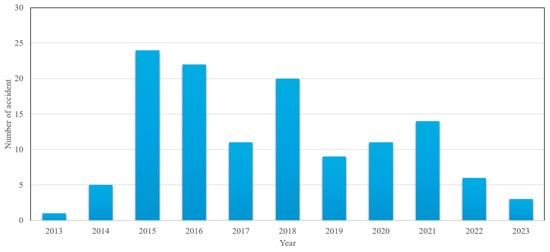
Figure 2.
Year distribution of sinking accident reports from 2013 to 2023.
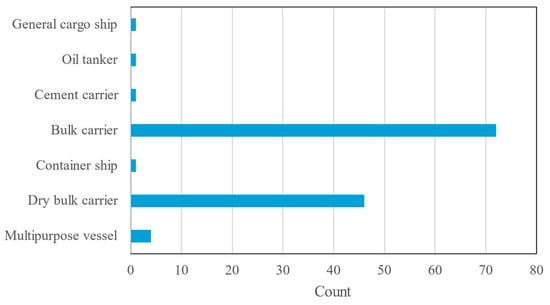
Figure 3.
Vessel types distribution.
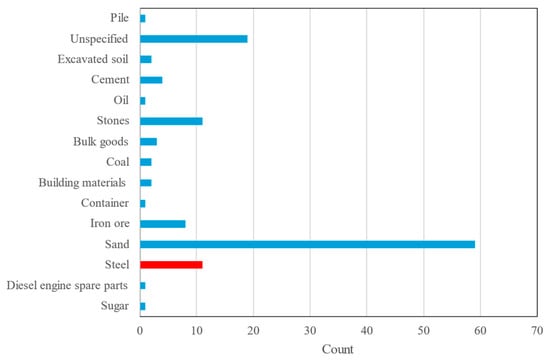
Figure 4.
Cargo types distribution.
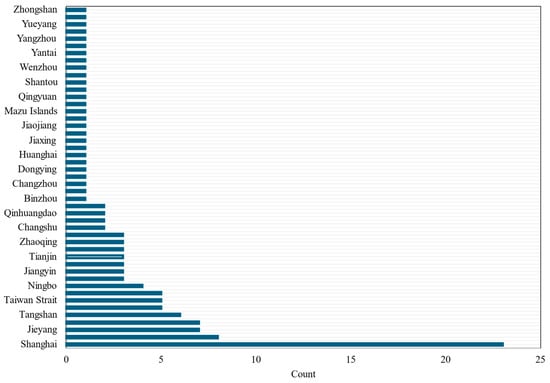
Figure 5.
Accident location distribution.
The geographical distribution of incidents reveals a concentration in specific coastal and port regions in China, such as Shanghai (23 incidents), Fuzhou (8), and Zhoushan (7). These areas have elevated risk levels due to high traffic volumes or challenging environmental conditions. Additionally, inland ports like Chongqing (2) and smaller regions like Binzhou (1) highlight the broader geographic spread of accidents. This distribution suggests that ship-sinking accidents are not confined to major coastal cities but also extend to less prominent ports and navigational areas.
Table 2 summarizes the primary causes and frequencies of maritime sinking incidents based on the collected reports. It categorizes the causes into several key areas. Crew management and cargo handling issues emerge as dominant causes, emphasizing the importance of crew training, certification, and safe loading practices. Weather-related factors and improper vessel maintenance also account for a significant proportion of incidents, emphasizing the need for strong environmental preparedness and regular vessel upkeep. This table helps identify common patterns in maritime sinking incidents.

Table 2.
Summary of accident causes and frequencies in collected maritime sinking incidents.
While SCVSA shares some risk factors with other vessel types, the distinct characteristics of steel cargo introduce unique challenges. These include higher risks of improper stowage and increased vulnerability to dynamic stability loss during navigation.
Uncertainty in data availability: SCVSA-specific reports accounted for only 11 cases (Figure 4), posing challenges for developing comprehensive risk models. To address this, supplementary data were derived from relevant studies on maritime risks (Section 3.2) and expert validation. This multi-source approach mitigates the impact of data scarcity by leveraging contextual insights and domain expertise.
(2) Expert validation and refinement:
To enhance the reliability and relevance of the data, five experts from the Shanghai Maritime Safety Administration were engaged in a structured validation process. Experts refined the identified risk phases, events, and factors specific to SCVSA and established causal relationships and interactions among these elements.
Handling uncertainty in expert opinions: Expert input was processed using a weighted scoring system (Table 3). This system accounted for field relevance, professional standing, experience, and academic contributions. This weighting framework ensured that expert opinions were contextually relevant and balanced subjective judgments with domain-specific qualifications.

Table 3.
Expert weight criteria.
- (1)
- Field relevance: experts directly involved in maritime safety were prioritized to ensure practical alignment with SCVSA complexities [].
- (2)
- Experience: experts with extensive years of experience in maritime safety practices were weighted higher due to their accumulated practical insights [].
- (3)
- Professional standing: higher-ranking experts were preferred for their strategic perspective and broad understanding of maritime safety issues [].
- (4)
- Academic contributions: experts with significant research output, such as multiple publications or active involvement in maritime studies, were given additional weight for their analytical capabilities [].
The weight scores and detailed information on selected experts are summarized in Table 4. These criteria ensured the selection of a highly qualified panel capable of refining the risk factors and causal relationships specific to SCVSA.

Table 4.
Profile and weight scores of experts.
3.2. Variables Identification
The lifecycle of a SCVSA can be divided into three interrelated stages. Each stage is characterized by specific risk events and underlying factors that influence the progression of incidents. This section elaborates on the identification of risk events and underlying factors.
3.2.1. Lifecycle Sinking Stages and Risk Events
The lifecycle of a SCVSA encompasses the following stages:
- (1)
- Failure, damage, or water ingress: This stage marks the initiation of incidents, such as structural failure, equipment malfunction, or external damage, triggering water ingress into the vessel. These initial failures create cascading vulnerabilities for subsequent stages.
- (2)
- Stability loss: As water floods the vessel, the distribution of steel cargo shifts due to movement or changes in the vessel’s inclination. This disrupts the vessel’s weight balance, severely impairing stability and increasing the likelihood of capsizing.
- (3)
- Sinking: continued water ingress ultimately overwhelms the vessel’s buoyancy, resulting in a complete loss of stability and leading to capsizing or sinking [].
Risk events are critical outcomes occurring during these stages, directly contributing to the progression of SCVSA. Table 5 and Figure 6 detail the specific risk events associated with each stage and their interrelationships. These events are modeled as interconnected nodes within a multi-level causal framework, enabling a comprehensive understanding of their interactions across the SCVSA lifecycle.

Table 5.
Potential risk events in steel cargo vessel sinking process.
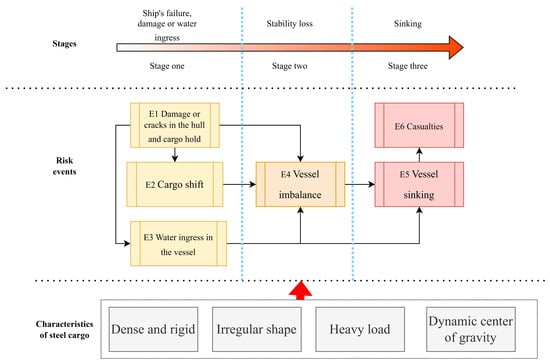
Figure 6.
Possible risk events of a steel cargo vessel sinking process.
3.2.2. Unique Characteristics of Steel Cargo Vessels and Risk Amplification
Steel cargo exhibits unique characteristics that significantly amplify SCVSA risks. As detailed in Figure 6 and Table 5, these characteristics include:
- (1)
- High density: steel’s substantial weight imposes structural stress on the vessel’s hull and cargo holds, increasing the likelihood of cracks and damage under dynamic maritime conditions.
- (2)
- Irregular shape: the varied shapes of steel cargo complicate proper securing, heightening the risk of cargo shifts that destabilize the vessel during transit.
- (3)
- Dynamic center of gravity: shifting cargo alters the vessel’s center of gravity, impairing stability and increasing vulnerability to external disturbances.
- (4)
- Accelerated water ingress: improperly secured steel cargo exacerbates flooding by widening cracks or breaches in the hull.
These characteristics collectively increase the risk of rapid sinking, making SCVs particularly vulnerable. Furthermore, steel cargo’s dense and rigid nature complicates rescue and salvage operations, amplifying the cascading effects of these risk events. These characteristics create a complex web of interrelated risk factors that must be accounted for in the risk model. Their effects are captured within the ISM framework, which systematically maps the hierarchical relationships between risk events and factors.
3.2.3. Risk Factors Identification
Risk factors are underlying conditions or circumstances that heighten the likelihood of these risk events. Table 6 identifies the specific risk factors for SCVSA, which are influenced by both the unique characteristics of steel cargo and the inherent vulnerabilities of SCVs:

Table 6.
Risk factors influencing steel cargo vessel sinking incidents.
- (1)
- Cargo characteristics: The high density and irregular shapes of steel cargo necessitate precise stowage and securing practices. These are often inadequately implemented due to limited crew expertise and weak regulatory oversight.
- (2)
- Vessel features: SCVs are typically smaller, older, and constructed with lower-quality materials, making them more prone to structural damage, water ingress, and propulsion failures.
- (3)
- Operational weaknesses: resource-constrained companies often operate these vessels with outdated safety management systems, insufficient maintenance practices, and inadequately trained crews.
This unique risk profile necessitates targeted management strategies to mitigate vulnerabilities and enhance safety during transportation.
3.3. ISM Model
The ISM method is employed to develop a hierarchical structure that reveals the intricate interrelationships among risk factors. The ISM-derived relationships are subsequently integrated into the FBN structure, enhancing the reliability of the risk assessment model and enabling more targeted risk mitigation strategies. This section outlines the step-by-step process of ISM implementation.
3.3.1. Structural Self-Interaction Matrix (SSIM) Construction
To represent direct relationships among risk factors, a structural self-interaction matrix (SSIM) is constructed. Let D denote the identified risk factors set. For each pair (, determine whether i directly influences j as expressed in Equation (1).
The SSIM is represented as A = , where n = .
Handling uncertainty in direct relationships: The direct relationships among risk factors in the SSIM are established conservatively. If at least one expert identifies a direct influence between two factors, the causal connection is included. To address uncertainties in the strength of these relationships, the results of the ISM are subsequently input into the FBN. In this step, five experts independently assign fuzzy scores to the strength of each causal relationship. These scores are then aggregated using a weighted integration approach, where expert weights are determined based on their qualifications, experience, and relevance to the domain. This method incorporates uncertainties in expert opinions, enhancing the robustness and reliability of the final risk assessment model.
3.3.2. Conversion to the Reachability Matrix
The SSIM is converted into a binary reachability matrix R to explore the indirect influences among risk factors. Assuming binary transitivity, if i directly influences j and j directly influences k, then i indirectly influences k. Let I denote the identity matrix. The reachability matrix R is computed iteratively through:
where I is the identity matrix, and r is the number of iterations required for the matrix to stabilize. The matrix R stabilizes as the number of iterations increases, eventually reaching a fixed state. This process is crucial for capturing indirect relationships among risk factors in ISM.
Learning mechanism in ISM: The iterative computation of R inherently serves as a learning mechanism. As r increases, the process progressively uncovers the indirect dependencies and causal relationships among the elements of the system. This iterative procedure adapts to the evolving data structure, ensuring a thorough exploration of the underlying relationships. The stabilization of R signifies the identification of a comprehensive set of causal dependencies among the variables.
3.3.3. Categorization of Risk Factors into Hierarchical Levels
To construct the hierarchical structure, each risk factor i is analyzed for its:
Reachability set R(i): all elements reachable from i (rij = 1).
Antecedent set A(i): all elements that can reach i (rji = 1).
Intersection set R(i)∩A(i): elements that both influence and are influenced by i.
Risk factors where R(i) = R(i)∩A(i) are assigned to the top level. These elements are removed from consideration and the process is repeated iteratively to categorize the remaining factors into multi-level structures.
3.3.4. Advantages and Robustness of ISM
The ISM model offers several advantages in analyzing SCVSA risks:
- (1)
- Comprehensive causal hierarchy visualization: ISM reveals both direct and indirect influences among multifaceted risk factors, providing a comprehensive understanding of their hierarchical structure and interdependencies.
- (2)
- Uncertainty incorporation: The model addresses uncertainties in the direct relationships between factors through a two-step process. During SSIM construction, a conservative approach is used: if at least one expert identifies a direct influence between two factors, this causal connection is proposed. To refine the strength of these relationships, the ISM results are then input into a FBN. In this step, five experts independently assign fuzzy scores to the strength of each relationship. These scores are aggregated using a weighted integration method, where expert weights are determined based on their qualifications, experience, and domain relevance. This two-layer approach ensures that uncertainties in expert judgments are systematically incorporated, enhancing the robustness and reliability of the risk assessment model.
- (3)
- Dynamic learning capability: the iterative process for computing the reachability matrix allows the model to adapt and refine the identified causal structure based on additional data or expert inputs.
Through this robust and systematic approach, the ISM model effectively uncovers the hierarchical interdependencies of SCVSA risk factors. This lays the foundation for the integration with the FBN framework for further probabilistic analysis.
3.4. Fuzzy Bayesian Network
The FBN combines fuzzy logic with Bayesian networks (BN) to manage uncertainty and temporal variations in complex systems. By integrating these techniques, FBN improves the accuracy and reliability of risk assessments. This facilitates more informed decision-making and the implementation of enhanced safety measures for SCVs.
3.4.1. FBN Structure
Figure 7 illustrates the process of integrating risk events and factors relationship into a BN structure.
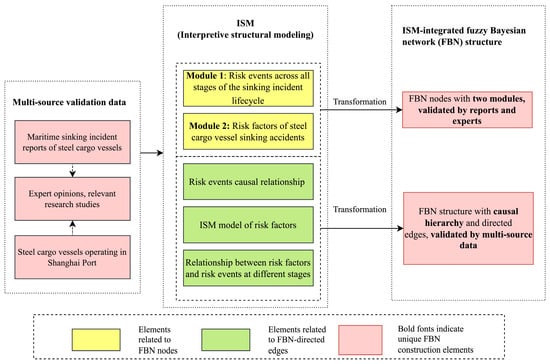
Figure 7.
Transformation process of ISM into a fuzzy Bayesian network.
The FBN differs from a traditional BN in three key aspects: modularization of nodes, hierarchical causal structure, and multi-source data validation mechanisms.
(1) Modularization of nodes
The FBN divides risk factors and multi-stage risk events into two distinct modules:
- Risk factors module: represents underlying conditions, such as cargo characteristics, vessel vulnerabilities, and operational weaknesses.
- Risk events module: captures multi-stage risk events, including failure initiation, stability loss, and sinking.
During the transformation into the FBN structure, causal relationships are mapped across:
- Risk factors within the same module.
- Risk events across different stages within the same module.
- Interactions between the two modules.
This modular approach provides greater flexibility, allowing each module to be updated independently as new data or insights emerge. In contrast, a single integrated BN structure may suffer from inconsistencies due to varied hierarchical standards, reducing accuracy and adaptability.
(2) Hierarchical causal structure
The FBN utilizes a hierarchical causal transmission structure derived from the ISM model. Unlike traditional BN, which often lacks differentiation between causal layers or allows for circular relationships, the FBN enforces:
- Directed nodes: causal relationships between nodes are explicitly defined based on ISM outputs, ensuring a clear directional flow of risk propagation.
- Level-specific dependencies: hierarchical layers distinguish how risks propagate across different levels, facilitating a structured analysis of interdependencies.
This structure eliminates ambiguities associated with undifferentiated or flat node relationships. It provides a more intuitive understanding of how individual risks contribute to SCVSA across multiple levels.
(3) Multi-source data validation mechanisms
To enhance the reliability of the FBN, the model incorporates validation using multiple data sources. This ensures that the identified risk factors and causal relationships are robust and contextually grounded. The validation process uses the following sources: empirical data from maritime accident reports, expert input for refinement, and insights from related studies. In contrast, traditional BN models typically rely on a single data source for validation. By combining diverse sources, the FBN offers a more comprehensive view of SCVSA risks, reducing dependence on any single dataset. This approach addresses uncertainties arising from limited SCV-specific cases and enhances the robustness and accuracy of the model, ensuring a more reliable representation of causal relationships.
3.4.2. Fuzzy Bayesian Network (FBN)
The FBN integrates fuzzy theory into the traditional Bayesian network (BN) framework to address the challenges of uncertainty, imprecision, and polymorphism inherent in the risk factors and events associated with SCVSA. This integration ensures the FBN can model scenarios where precise probabilities are unavailable or difficult to determine. This flexibility is crucial in SCVSA, where obtaining comprehensive prior and conditional probabilities for multi-risk factors and multi-stage risk events is challenging due to limited and incomplete accident reports. Moreover, maritime experts often find it difficult to provide exact numerical probabilities for such complex and variable risks. By using fuzzy variables, the FBN accommodates expert assessments qualitatively, capturing their judgments and the associated uncertainty without requiring exact numerical inputs. This approach ensures a more robust and realistic representation of the risk landscape.
(1) Fuzzy scoring system design based on causal scenarios in the FBN for SCVSA.
A fuzzy scoring system was designed to gather expert opinions on the likelihood of parent nodes and conditional probability table (CPT) values, as summarized in Table 7. In a BN, a CPT defines the relationship between a node and its parent nodes through conditional probabilities. The scoring system accounts for causal relationships between nodes in the FBN (demonstrated in Section 4.1), reflecting the uncertainty and variability inherent in expert judgments.

Table 7.
Fuzzy scales.
(2) Aggregation of expert opinions.
To harmonize the differences in expert assessments, a weighted averaging method is used to aggregate triangular fuzzy numbers (TFNs). The weight (wi) assigned to the i-th expert each reflects his/her qualifications, domain expertise, and relevance to SCVSA. The aggregated TFNs for each node are computed using the following formulas:
Here, m denotes the number of experts. TFN (ai, bi, ci) represents the TFN provided by the i-th expert. This process ensures that the aggregated values maintain the uncertainty and variability of expert inputs while reflecting their relative reliability.
(3) Prior probability estimation.
The aggregated TFNs are defuzzied into a single crisp value D using the centroid method:
This defuzzified value serves as the prior probability for nodes without parent nodes, providing a holistic representation of expert assessments. By using the centroid method, the FBN captures the full range of possible values within the fuzzy set, ensuring a comprehensive and realistic depiction of uncertainty.
(4) CPT estimation.
The conditional probability of a node refers to the likelihood of the node occurring given the information from its parent nodes. For nodes with parent nodes, the conditional probabilities are estimated similarly.
For a node E influenced by parent nodes A, B, …, N, expert ratings are collected for each combination of parent node states (Ai, Bj, …, Nk). These ratings are then converted into TFNs (am, bm, and cm). aij…k, bij…k, and cij…k are the lower, middle, and upper values of the TFNs respectively. The aggregated TFNs for these combinations are calculated using the following formulas:
The aggregated TFNs are then defuzzified using the centroid method to derive crisp conditional probabilities, which populate the CPT for each node.
Based on accident reports and expert opinions, each node is set to have two possible states, as shown in Table 8.

Table 8.
Fuzzy Bayesian network nodes states.
The conditional probability of node E being in states 1 and 2, given the specific values of the parent nodes, is calculated as shown in Equations (10) and (11), respectively.
This process ensures that the dependencies between parent and child nodes are accurately represented while capturing the uncertainty in expert judgments.
(5) Consensus and divergence handling
To assess and address the consistency and divergence of expert ratings, several statistical measures are employed:
- Central tendency: The mean and median assess the alignment of expert ratings. Values that are close together suggest that the expert ratings are more consistent with each other.
- Variability metrics: The standard error and standard deviation quantify the variability of the ratings. Smaller values suggest higher consistency among experts. The range captures the spread of ratings. The confidence interval provides an estimate of the reliability and precision of the aggregated scores, with narrower intervals indicating greater agreement.
- Distribution characteristics: Skewness evaluates the symmetry of the ratings distribution, where values near zero suggest balanced ratings. Kurtosis highlights the concentration of ratings around central values.
These measures collectively ensure that expert ratings are consistent, robust, and reflective of shared consensus while identifying and mitigating any significant discrepancies.
Discrepancies in expert ratings are addressed through iterative feedback and refinement. Outliers or extreme values are evaluated to ensure they do not disproportionately affect the final aggregated results.
To ensure logical consistency and robustness, the FBN employs three fundamental axioms and sensitivity analysis:
Axiom 1: significant changes in the prior probabilities of parent nodes result in meaningful and proportional changes in the posterior probabilities of their child nodes, ensuring logical consistency in causal relationships.
Axiom 2: variations in parent node probabilities consistently influence the child nodes, providing a reliable framework for assessing interdependencies.
Axiom 3: the cumulative influence of multiple parent nodes exceeds that of any single parent node, validating the logical structure of multi-factorial causation.
Sensitivity analysis identifies key influencing factors and quantifies the impact of parent nodes on child nodes. This process highlights critical dependencies and facilitates the detection of inconsistencies or vulnerabilities in expert assessments.
3.4.3. Uncertainty Incorporation and Learning Mechanism
The FBN incorporates uncertainty through the following mechanisms:
- (1)
- Fuzzy scoring of relationships: Expert opinions on the strength of causal links are represented using triangular fuzzy numbers (TFNs). These encode the minimum, most likely, and maximum values for each causal relationship. This approach allows the model to quantitatively capture variability in human judgments while accommodating the uncertainty associated with qualitative assessments.
- (2)
- Threshold-based confidence levels: Relationships identified during ISM construction are further refined in the FBN using fuzzy scores as input for probabilistic calculations. A conservative threshold ensures that any relationship supported by at least one expert is retained. The aggregated fuzzy scores reflect the strength of expert consensus. This method ensures the robustness of the model, even under conditions of disagreement or uncertainty among experts.
- (3)
- Probabilistic modeling: the Bayesian component of the FBN integrates fuzzy inputs to compute conditional probabilities for risk events and factors. This probabilistic framework dynamically accounts for uncertainties across all modules, enabling the model to provide more reliable and adaptive risk assessments for SCVSA.
The FBN incorporates a learning mechanism by iteratively updating its structure and parameters as new data become available. Specifically:
- (1)
- Parameter learning: Conditional probabilities between nodes are continuously refined using updated accident data or new expert inputs. This ensures that the model remains data-driven and reflects the latest evidence and expert consensus, enhancing its predictive accuracy over time
- (2)
- Structural updates: The modular design of the FBN facilitates the addition, removal, or reorganization of nodes and edges without compromising the overall framework’s integrity. This flexibility supports the integration of new risk factors or evolving causal relationships as more data become available.
By combining uncertainty analysis with learning, the FBN remains robust in handling incomplete or imprecise information while adapting to new insights. The iterative refinement of probabilities and structure enables the model to provide dynamic and realistic representations of SCVSA risks, offering a valuable tool for decision-making in maritime safety.
4. Results
4.1. Data Description and Consistency
Five experts from the Shanghai Maritime Safety Administration provided fuzzy scores for the occurrence probabilities of parent nodes and the conditional probabilities of causal scenarios. These estimates were based on observations of SCVs at Shanghai Port, China. Due to space limitations, Table 9 presents the fuzzy probability scores of parent nodes in the FBN. Table 10 details the CPT analysis for “E2”.

Table 9.
Linguistic expert judgments for the parent nodes under state 1.

Table 10.
Linguistic expert judgments for CPT of node E2 under state 1.
To assess the consistency and robustness of experts’ ratings for prior probabilities and CPT, several statistical measures were calculated. The measures include mean, median (Figure 8), standard error, standard deviation, range, confidence interval (Figure 9), skewness, and kurtosis (Figure 10). The alignment of the mean and median in Figure 8 indicates a symmetric data distribution with concentrated ratings. Figure 9 shows small standard errors (0.2) and standard deviations (0.447), reflecting low dispersion and high consistency. A uniform range of 1 across nodes further supports tightly clustered ratings. The confidence interval, spanning 0.391 to 0.480, demonstrates strong reliability. As shown in Figure 10, skewness values near zero indicate symmetry, while deviations highlight asymmetry. Positive kurtosis suggests a concentrated distribution, whereas negative kurtosis points to flatter data. Overall, the statistical analysis confirms that the expert ratings are consistent, reliable, and robust, with minimal variability and high agreement.
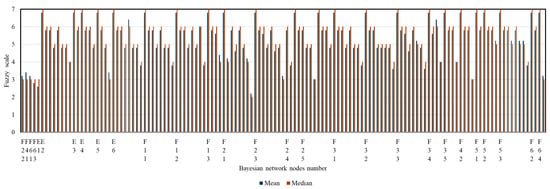
Figure 8.
Mean and median for expert ratings on prior probabilities and conditional probability tables.
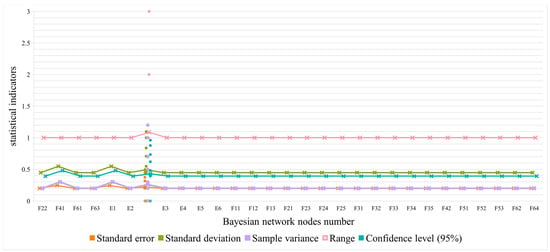
Figure 9.
Box-plot of standard error, standard deviation, variance, range, and confidence level for expert ratings on prior probabilities and conditional probability tables.
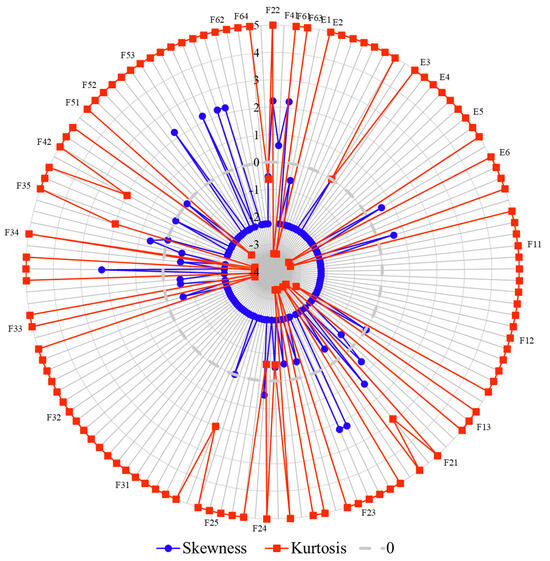
Figure 10.
Skewness and kurtosis for expert ratings on prior probabilities and conditional probability tables.
4.2. Model Structure
Figure 11 illustrates the ISM model structure, which serves as the foundation for the FBN model shown in Figure 12. The FBN model was developed using NETICA software, version 5.18.0.0 based on the relationships established in the ISM model.

Figure 11.
ISM model of risk factors in SCVSA.
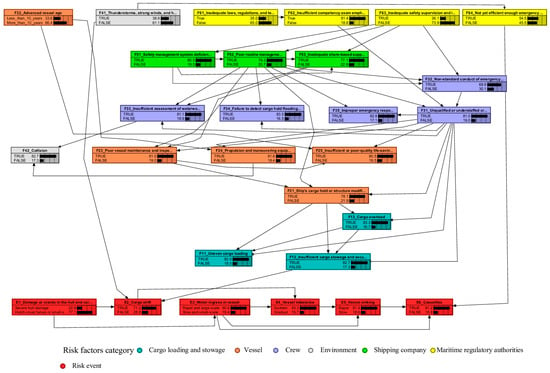
Figure 12.
FBN model for SCVSA.
4.3. Robustness of FBN
Verifying the FBN model is essential to ensure its reliability and accuracy. A robust FBN model must adhere to three fundamental axioms [,].
Axiom 1 states that significant changes in the prior probability of a parent node should result in proportional and meaningful changes in the posterior probability of its child nodes. This relationship is confirmed in Table 11, which illustrates how variations in parent node probabilities affect the corresponding child node probabilities.

Table 11.
Axiom 1 test for cargo shift (E2).
Axiom 2 requires that changes in the prior probabilities of parent nodes consistently influence the probabilities of their child nodes. This consistency is demonstrated in Figure 13, showing how variations in parent node probabilities impact the likelihood of the child node “Casualties”.
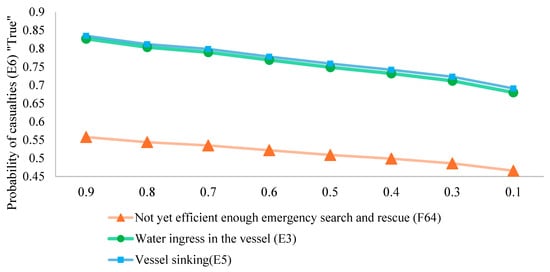
Figure 13.
Axiom 2 test for casualties.
According to Axiom 3, the cumulative influence of multiple parent nodes on a child node must exceed that of any single parent node (Table 12). The model satisfies this criterion and successfully passes all three axiom tests, confirming the validity of the FBN.

Table 12.
Axiom 3 test for F21.
4.4. Sensitivity Analysis
Table 13 presents sensitivity results, highlighting the mutual information between multi-stage risk events and the top ten influencing factors, providing insights into the key drivers of risk progression.

Table 13.
Sensitivity analysis of the top ten risk factors on multi-stage risk events.
5. Discussion
This section discusses the results in Section 4.2 and Section 4.3, along with the insights derived from them.
5.1. Causal Hierarchies of SCVSA
5.1.1. Root Causes and Direct Contributors to SCVSA
The causal hierarchies of SCVSA were analyzed based on Figure 11, identifying root causes and their cascading effects. The primary root causes include advanced vessel age (F22), thunderstorms, strong winds, and high waves (F41), and deficiencies in maritime regulatory frameworks. The associated probabilities for the key factors are as follows: F62 (insufficient competency exams on cargo stowage and securing), 81.4%; F22 (advanced vessel age), 66.4%; F64 (inefficient emergency response and rescue), 54.5%; F41 (adverse weather conditions), 38.9%; F61 (inadequate laws, regulations, and technical standards), 35.3%; and F63 (inadequate safety supervision and inspection), 26.1%.
Older vessels exhibit higher probabilities of propulsion and maneuvering equipment failure (F24) and poor-quality life-saving equipment (F25). Adverse weather (F41) significantly impacts rescue efficiency and increases the likelihood of cargo shifts. Regulatory deficiencies (F61) contribute to F62, while F63 is linked to unqualified or understaffed crew (F31), triggering non-standard emergency drills (F32), poor safety management systems (F51), ineffective routine management (F52), and insufficient shore-based support (F53). Ultimately, F64 directly elevates the likelihood of casualties (E6).
Cargo loading and stowage are direct contributors to SCVSA. Key probabilities include: F13 (cargo overload), 83.3%; F12 (insufficient cargo stowage and securing), 82.7%; and F11 (uneven cargo loading), 82%. F12 leads to cargo shifts (E2), while F13 contributes to both F11 and F12.
5.1.2. Intermediate Risk Transmission Hierarchy
The intermediate risk factors from deeper to surface layers flow from shipping companies to crew and then to vessel and environment.
Shipping company-related risks include: F51 (safety management system deficiencies), 80.5%; F52 (poor routine management), 79.3%; and F53 (inadequate shore-based support), 77.1%. F51 influences F32, F52, and F53, while F52 drives crew and vessel-related risks, such as cargo hold modifications (F21), poor vessel maintenance (F23), unqualified crew (F31), non-standard emergency drills (F32), failure to detect flooding (F34), and improper emergency responses (F35). F53 further impacts F23 and insufficient waterway risk assessment (F33).
Crew-related risks are central to SCVSA, with probabilities including: F34 (failure to detect flooding), 83.5%; F35 (improper emergency response), 82.9%; F33 (insufficient waterway risk assessment), 81.1%; F31 (unqualified or understaffed crew), 81%; and F32 (non-standard conduct of emergency drills), 69.9%. F31 directly affects all cargo loading and stowage risks and most vessel-related risks, except F22. F32 can trigger F31, while F33 increases the likelihood of collisions (F42).
Vessel and environment-related risks have the following probabilities: F42 (collisions), 82.7%; F24 (propulsion and maneuvering failure), 81.6%; F23 (poor vessel maintenance), 81%; F25 (poor-quality life-saving equipment), 80.5%; and F21 (cargo hold modifications), 78.1%. F21 impacts all cargo loading and stowage-related risks. F23 causes F21 and F25, while F24 can lead to F42.
5.2. Multi-Stage Risk Factors of SCVSA
Table 13 identifies key factors significantly contributing to multi-stage risk events, such as cargo shifting, vessel imbalance, sinking, and casualties. The most critical factors include thunderstorms, strong winds, and high waves (F41), insufficient emergency search and rescue (F64), and insufficient cargo stowage and securing (F12).
- F41 has the highest mutual information value (0.01097) for cargo shifting and impacts vessel imbalance, sinking, and casualties.
- F64 significantly affects casualties (E6) with a mutual information value of 0.00416.
- F12 strongly influences cargo shifting (mutual information value of 0.00931), which can cascade into vessel imbalance and other risk events.
Other factors, such as cargo overload, unqualified or understaffed crew, uneven cargo loading, poor vessel maintenance, inadequate routine management, delays in detecting cargo hold flooding or severe deck water accumulation, and improper emergency response, exhibit relatively low mutual information values. While their individual impact may appear limited, these factors remain vital in risk management, as they can act as secondary triggers under adverse conditions.
This analysis highlights the primary and secondary factors influencing SCVSA, providing a basis for prioritizing mitigation strategies.
5.3. Lifecycle Risk of SCVSA
Figure 6 and Figure 12 illustrate the risk evolution pathway for SCVSA. The initial events include damage or cracks in the hull and cargo hold (E1) and cargo shift (E2). The probability of hatch cover failure or minor cracks (77.1%) is significantly higher than that of severe hull damage (22.9%). E2 can act as either an initiating event or a consequence of E1, with a high occurrence probability (71.2%). Similarly, water ingress (E3) may either initiate the sequence or follow from E1, with rapid and large-scale ingress (80.6%) being far more likely than slow and small-scale ingress (19.4%).
The subsequent event, vessel imbalance (E4), has a high likelihood of sudden onset (83.3%), often leading to rapid loss of control and minimal time for emergency response. The final outcomes are vessel sinking (E5) and casualties (E6). The probability of rapid sinking is 81.4%, substantially exceeding that of a slower descent (18.6%), underscoring the urgent need for immediate action. Casualties, including injuries, missing persons, or fatalities, have an 81.2% probability, further highlighting the critical importance of timely emergency measures.
The risk events in SCVSA are highly interlinked, creating cascading effects where the occurrence of one event significantly increases the likelihood of subsequent events. This chain reaction emphasizes the necessity of robust preventive measures and efficient emergency response systems to mitigate risks effectively.
5.4. Implications
This section outlines actionable strategies to address the identified key risks associated with SCVSA. The recommendations incorporate economic and logistical considerations to enhance applicability, addressing SCVs’ unique vulnerabilities and operational challenges.
5.4.1. Aging SCVs (F22)
Section 5.1 identifies advanced vessel age (F22) as a major cause of SCVSA, with significant risk transmission pathways linked to outdated vessels. Recommendations to promote fleet modernization are as follows:
- Policy support: Provide financial incentives, such as tax breaks or low-interest loans, to help small and medium-sized shipping companies replace aging SCVs with modern ones. This would reduce maintenance costs and improve safety. Develop government-backed programs to support modernization, including public–private partnerships and phased timelines for compliance.
- Evaluate costs and benefits: conduct economic analyses for SCVs to compare the upfront costs of modernization with potential savings, such as lower maintenance expenses, reduced insurance premiums, and structural failure rates.
5.4.2. Adverse Meteorological and Sea Conditions (F41)
Section 5.1 and Section 5.2 highlight that thunderstorms, strong winds, and high waves (F41) are root causes of cascading risk events. Recommendations to enhance SCV stability and operational safety in challenging maritime conditions are as follows:
- Pre-departure risk assessments: enforce checks before departure, including route planning, cargo securing, and watertight doors.
- Improve weather and sea condition monitoring: collect meteorological and sea conditions data from multiple sources, issue real-time weather and sea condition alerts for SCVs in high-risk areas, enhance monitoring of SCV movements, and strengthen shore-to-ship communication.
- Navigation route optimization: Optimize SCV routes based on real-time meteorological and sea conditions. Integrate intelligent navigation on SCVs to reduce weather-induced accidents.
- Prompt closure of watertight doors: if waves and winds intensify, watertight doors on SCVs must be promptly closed.
5.4.3. Inadequate Maritime Regulations (F61–F64)
Section 5.1 and Section 5.2 reveal that regulatory deficiencies (F61–F64) significantly contribute to SCVSA. Addressing these gaps requires the following tailored regulatory measures for SCVs:
- Specialized competency standards: require SCV captains to hold certifications specific to steel cargo handling, including stowage and securing practices.
- Enhance inspection and supervision: Conduct monthly maritime safety inspections, focusing on small shipping companies and older vessels. Implement a permit system for steel cargo loading and unloading, with technical supervisors ensuring compliance with the Cargo Securing Manual and vessel stability standards.
- Strengthen emergency response: Deploy emergency wreck marking buoys, rapid response vessels, and aerial support (e.g., drones or helicopters) in high-risk zones. Establish multi-agency emergency command systems and conduct regular drills to improve preparedness.
- Cargo securing protocols: Develop comprehensive securing checklists for cargo owners and ship operators. Introduce a professional lashing company registry and regulate lashing team management to standardize practices.
5.4.4. Inadequate Cargo Stowage and Securing (F12)
Section 5.2 highlights insufficient cargo stowage and securing (F12) as a critical contributor to multi-stage risk events. SCVs are particularly vulnerable to cargo shift and imbalance. Recommendations to address the unique stowage and securing challenges of steel cargo, reducing risks of instability, are as follows:
- Loading practices: Use electronic scales to ensure proper weight distribution and stability. Use IoT-enabled monitoring systems during loading to detect imbalances in real time.
- Crew training: Conduct regular training workshops on updated steel cargo handling protocols. Certify lashing professionals to standardize practices.
- Terminal safety enforcement: train dockworkers in standardized securing procedures and promote collaboration with certified lashing companies.
- Cost allocation: mandate that cargo owners share securing costs to discourage cost-cutting measures by operators.
5.4.5. Structural Integrity and Emergency Preparedness (Hatch Cover Failures and Hull Cracks)
Section 5.3 indicates a high probability (77.1%) of hatch cover failure and small hull cracks, leading to cascading risk events. To address these issues, the following robust preventive and emergency measures are essential:
- Maintenance and regular inspections: Conduct regular structural inspections and maintain logs for critical components. Adopt advanced non-destructive testing to detect potential issues early. Increase the frequency of inspections for key components on older SCVs.
- Emergency drills: conduct monthly joint emergency drills for both shore-based personnel and crew to improve preparedness and response capabilities.
- Enhanced standards: classification societies, inspection agencies, and shipyards should enforce stricter inspection standards tailored to SCVs.
6. Conclusions
This study integrates ISM and FBN to analyze the interrelationships among risk factors and the lifecycle risks of steel cargo vessel sinking accidents (SCVSA). The key root causes identified include advanced vessel age, severe weather and sea conditions, and deficiencies in maritime regulatory oversight. Poor cargo loading and stowage practices exacerbate the risk of cargo shifts, directly leading to vessel sinking.
This study also reveals the intermediate hierarchical nature of risk transmission. It begins with shipping companies, affects crew practices, and ultimately influences vessel conditions and environmental factors. Multi-stage risks include thunderstorms, strong winds, high waves, inadequate emergency responses, and insufficient cargo securing. SCVSA exhibit cascading risk effects: initial failures, such as minor hull cracks or hatch cover malfunctions, trigger cargo shifts and rapid water ingress. This destabilizes the vessel, causing imbalances that result in rapid sinking and potential casualties.
The main contributions of this research are as follows:
- Causal framework for SCVSA risk factors: This study employs ISM to establish a hierarchical causal structure for SCVSA risk factors. By incorporating elements from cargo stowage practices, shipping companies, and regulatory authorities, this study offers a more comprehensive view of risk propagation pathways.
- Lifecycle risk evaluation of SCVSA: A FBN model, built on the ISM analysis, enables a detailed evaluation of lifecycle risks. This advancement improves upon maritime risk assessment methods.
- Identification of multi-stage risks: This study uncovers critical multi-stage risk factors spanning different phases of SCVSA. These insights help stakeholders implement targeted interventions to enhance maritime safety.
Expanding data collection to include SCVSA in other regions and over a longer time frame could offer a more global perspective. Currently, the dataset primarily focuses on Chinese coastal and port areas, potentially overlooking accidents in international waters or underreported regions. A broader dataset would reduce geographical bias and enhance the generalizability of the findings.
Further refining the identified risk factors could improve the predictive accuracy of the model. Incorporating additional variables could provide deeper insights into SCVSA causation and mitigation strategies.
Future studies could evaluate the costs and benefits of implementing the proposed recommendations. For instance, assessing the economic feasibility of fleet modernization could help stakeholders balance safety improvements with financial constraints.
Integrating expert experience with artificial intelligence (AI) methods could create interpretable and reliable risk assessment models. AI-based models, combined with domain expertise, can better capture the complex multi-stage nature of SCVSA and provide actionable insights.
Author Contributions
Conceptualization, X.J., H.X. and Y.Z.; methodology, X.J. and Y.G.; software, X.J.; validation, X.J.; formal analysis, Y.G.; data curation, H.X.; writing—original draft preparation, X.J., H.X., Y.Z. and Y.G.; writing—review and editing, X.J., H.X., Y.G. and S.Z.; visualization, X.J. and Y.G.; supervision, S.Z.; funding acquisition, X.J. All authors have read and agreed to the published version of the manuscript.
Funding
This research was funded by the Shanghai Sailing Program (21YF1416500, 23YF1416500), National Natural Science Foundation of China (72074141), Ministry of Education of Humanities and Social Science Research Planning Fund Project (23YJA630120), Ministry of Education of Humanities and Social Science Research Youth Funded Project (23YJC630133, 24YJCZH399), Shanghai Innovation and Entrepreneurship Training Program (S20240213).
Institutional Review Board Statement
Not applicable.
Informed Consent Statement
Not applicable.
Data Availability Statement
Data are contained within the article. Further inquiries can be directed to the corresponding author.
Conflicts of Interest
The authors declare no conflicts of interest.
Note
| 1 | Steel cargo vessels operating in Shanghai Port exhibit the above characteristics. |
References
- Hussain, A.; Ullah, K.; Pamucar, D.; Simic, V. Intuitionistic fuzzy Sugeno-Weber decision framework for sustainable digital security assessment. Eng. Appl. Artif. Intell. 2024, 137, 109085. [Google Scholar] [CrossRef]
- Hussain, A.; Wang, H.; Ullah, K.; Pamucar, D. Novel intuitionistic fuzzy Aczel Alsina Hamy mean operators and their applications in the assessment of construction material. Complex Intell. Syst. 2024, 10, 1061–1086. [Google Scholar] [CrossRef]
- Zhao, Z.; Hussain, A.; Zhang, N.; Ullah, K.; Yin, S.; Awsar, A.; El-Bahy, S.M. Decision support system based on bipolar complex fuzzy Hamy mean operators. Heliyon 2024, 10, e36461. [Google Scholar] [CrossRef] [PubMed]
- Psarros, G.A.; Vassalos, D. Risk analysis of bulk carriers. Ships Offshore Struct. 2010, 5, 199–209. [Google Scholar] [CrossRef]
- Mulyadi, Y.; Kobayashi, E.; Wakabayashi, N.; Pitana, T.; Wahyudi. Development of ship sinking frequency model over subsea pipeline for Madura Strait using AIS data. WMU J. Marit. Aff. 2014, 13, 43–59. [Google Scholar] [CrossRef]
- Waskito, D.H.; Bowo, L.P.; Puriningsih, F.S.; Muhtadi, A.; Kurniawan, I. Comprehensive analysis of ship sinking accidents using Bayesian network. Aust. J. Marit. Ocean Aff. 2024, 1–24. [Google Scholar] [CrossRef]
- Akyuz, E.; Celik, M. A hybrid human error probability determination approach: The case of cargo loading operation in oil/chemical tanker ship. J. Loss Prev. Process Ind. 2016, 43, 424–431. [Google Scholar] [CrossRef]
- Kaptan, M. Estimating human error probability in transporting steel cargo with bulk carriers using a hybrid approach. Proc. Inst. Mech. Eng. Part M J. Eng. Marit. Environ. 2022, 236, 303–314. [Google Scholar] [CrossRef]
- Wang, J.; Zhou, Y.; Zhang, S.; Zhuang, L.; Shi, L.; Chen, J.; Hu, D. Societal risk acceptance criteria of the global general cargo ships. Ocean Eng. 2022, 261, 112162. [Google Scholar] [CrossRef]
- Khan, R.U.; Yin, J.; Mustafa, F.S.; Anning, N. Risk assessment for berthing of hazardous cargo vessels using Bayesian networks. Ocean Coast Manag. 2021, 210, 105673. [Google Scholar] [CrossRef]
- Wang, L.; Wang, J.; Shi, M.; Fu, S.; Zhu, M. Critical risk factors in ship fire accidents. Marit. Policy Manag. 2021, 48, 895–913. [Google Scholar] [CrossRef]
- Chen, P.; Zhang, Z.; Huang, Y.; Dai, L.; Hu, H. Risk assessment of marine accidents with Fuzzy Bayesian Networks and causal analysis. Ocean Coast Manag. 2022, 228, 106323. [Google Scholar] [CrossRef]
- Tunçel, A.L.; Beşikçi, E.B.; Akyuz, E.; Arslan, O. Safety analysis of fire and explosion (F&E) accidents risk in bulk carrier ships under fuzzy fault tree approach. Saf. Sci. 2023, 158, 105972. [Google Scholar]
- Cao, Y.; Wang, X.; Wang, Y.; Fan, S.; Wang, H.; Yang, Z.; Liu, Z.; Wang, J.; Shi, R. Analysis of factors affecting the severity of marine accidents using a data-driven Bayesian network. Ocean Eng. 2023, 269, 113563. [Google Scholar] [CrossRef]
- Li, H.; Zhou, K.; Zhang, C.; Bashir, M.; Yang, Z. Dynamic evolution of maritime accidents: Comparative analysis through data-driven Bayesian Networks. Ocean Eng. 2024, 303, 117736. [Google Scholar] [CrossRef]
- Li, P.; Wang, Y.; Yang, Z. Risk assessment of maritime autonomous surface ships collisions using an FTA-FBN model. Ocean Eng. 2024, 309, 118444. [Google Scholar] [CrossRef]
- Fan, S.; Yang, Z. Accident data-driven human fatigue analysis in maritime transport using machine learning. Reliab. Eng. Syst. Saf. 2024, 241, 109675. [Google Scholar] [CrossRef]
- Guo, T.; Xie, L.; Zhang, J.; Zhao, J.; Zhou, H. An Integrated Framework for Analyzing Risk Influence Factors of Inland Waterway Transport Based on Interpretive Structural Models and Bayesian Networks. ASCE-ASME J. Risk Uncertain. Eng. Syst. Part A Civ. Eng. 2024, 10, 04024045. [Google Scholar] [CrossRef]
- Cao, W.; Wang, X.; Li, J.; Zhang, Z.; Cao, Y.; Feng, Y. A novel integrated method for heterogeneity analysis of marine accidents involving different ship types. Ocean Eng. 2024, 312, 119295. [Google Scholar] [CrossRef]
- Gao, D.; Zhu, Y.; Yan, K.; Soares, C.G. Deep learning–based framework for regional risk assessment in a multi–ship encounter situation based on the transformer network. Reliab. Eng. Syst. Saf. 2024, 241, 109636. [Google Scholar] [CrossRef]
- Battineni, G.; Chintalapudi, N.; Ricci, G.; Ruocco, C.; Amenta, F. Exploring the integration of artificial intelligence (AI) and augmented reality (AR) in maritime medicine. Artif. Intel. Rev. 2024, 57, 100. [Google Scholar] [CrossRef]
- Xiao, G.; Wang, Y.; Wu, R.; Li, J.; Cai, Z. Sustainable maritime transport: A review of intelligent shipping technology and green port construction applications. J. Mar. Sci. Eng. 2024, 12, 1728. [Google Scholar] [CrossRef]
- Xiao, G.; Yang, D.; Xu, L.; Li, J.; Jiang, Z. The application of artificial intelligence technology in shipping: A bibliometric review. J. Mar. Sci. Eng. 2024, 12, 624. [Google Scholar] [CrossRef]
- Yang, X.; Mahmood, T.; Ali, Z.; Hayat, K. Identification and classification of multi-attribute decision-making based on complex intuitionistic fuzzy frank aggregation operators. Mathematics 2023, 11, 3292. [Google Scholar] [CrossRef]
- Ali, Z.; Mahmood, T.; Yang, M.-S. TOPSIS method based on complex spherical fuzzy sets with Bonferroni mean operators. Mathematics 2020, 8, 1739. [Google Scholar] [CrossRef]
- Wachinger, G.; Renn, O.; Begg, C.; Kuhlicke, C. The risk perception paradox—Implications for governance and communication of natural hazards. Risk Anal. 2013, 33, 1049–1065. [Google Scholar] [CrossRef]
- Turna, İ. A safety risk assessment for ship boarding parties from fuzzy Bayesian networks perspective. Marit. Policy Manag. 2024, 51, 1–14. [Google Scholar] [CrossRef]
- Abramo, G.; D’Angelo, C.A.; Di Costa, F. Research productivity: Are higher academic ranks more productive than lower ones? Scientometrics 2011, 88, 915–928. [Google Scholar] [CrossRef]
- Vassalos, D.; Paterson, D.; Mauro, F.; Mujeeb-Ahmed, M.; Boulougouris, E. Process, methods and tools for ship damage stability and flooding risk assessment. Ocean Eng. 2022, 266, 113062. [Google Scholar] [CrossRef]
- Pilatis, A.N.; Pagonis, D.-N.; Serris, M.; Peppa, S.; Kaltsas, G. A Statistical Analysis of Ship Accidents (1990–2020) Focusing on Collision, Grounding, Hull Failure, and Resulting Hull Damage. J. Mar. Sci. Eng. 2024, 12, 122. [Google Scholar] [CrossRef]
- Nwigwe, T.; Kiyokazu, M. Statistical analysis of bulk carrier accident from 2011 to 2020. TransNav 2022, 16, 153–157. [Google Scholar] [CrossRef]
- Kim, J.-S.; Roh, M.-I.; Ham, S.-H. A method for intermediate flooding and sinking simulation of a damaged floater in time domain. J. Comput. Des. Eng. 2017, 4, 1–13. [Google Scholar] [CrossRef][Green Version]
- Vassalos, D. Damage stability and survivability—‘Nailing’ passenger ship safety problems. Ships Offshore Struct. 2014, 9, 237–256. [Google Scholar] [CrossRef]
- Vassalos, D.; Paterson, D. Towards unsinkable ships. Ocean Eng. 2021, 232, 109096. [Google Scholar] [CrossRef]
- Hu, S.; Li, Z.; Xi, Y.; Gu, X.; Zhang, X. Path analysis of causal factors influencing marine traffic accident via structural equation numerical modeling. J. Mar. Sci. Eng. 2019, 7, 96. [Google Scholar] [CrossRef]
- Onyshchenko, S.; Shibaev, O.; Melnyk, O. Assessment of potential negative impact of the system of factors on the ship’s operational condition during transportation of oversized and heavy cargoes. Trans. Marit. Sci 2021, 10, 126–134. [Google Scholar] [CrossRef]
- Chen, S.-T.; Wall, A.; Davies, P.; Yang, Z.; Wang, J.; Chou, Y.-H. A Human and Organisational Factors (HOFs) analysis method for marine casualties using HFACS-Maritime Accidents (HFACS-MA). Saf. Sci. 2013, 60, 105–114. [Google Scholar] [CrossRef]
- Yıldırım, U.; Başar, E.; Uğurlu, Ö. Assessment of collisions and grounding accidents with human factors analysis and classification system (HFACS) and statistical methods. Saf. Sci. 2019, 119, 412–425. [Google Scholar] [CrossRef]
- Schröder-Hinrichs, J.U.; Baldauf, M.; Ghirxi, K.T. Accident investigation reporting deficiencies related to organizational factors in machinery space fires and explosions. Accid. Anal. Prev. 2011, 43, 1187–1196. [Google Scholar] [CrossRef] [PubMed]
- Fan, H.; Lu, J.; Chang, Z.; Ji, Y. A Bayesian network-based TOPSIS framework to dynamically control the risk of maritime piracy. Marit. Policy Manag. 2024, 51, 1582–1601. [Google Scholar] [CrossRef]
Disclaimer/Publisher’s Note: The statements, opinions and data contained in all publications are solely those of the individual author(s) and contributor(s) and not of MDPI and/or the editor(s). MDPI and/or the editor(s) disclaim responsibility for any injury to people or property resulting from any ideas, methods, instructions or products referred to in the content. |
© 2025 by the authors. Licensee MDPI, Basel, Switzerland. This article is an open access article distributed under the terms and conditions of the Creative Commons Attribution (CC BY) license (https://creativecommons.org/licenses/by/4.0/).